Contents
Market Overview
Macro Update
The Federal Open Market Committee (FOMC) delivered a widely anticipated 25bps cut to the Fed Funds Rate target range, bringing it down to 4%-4.25% at its September meeting. Notably, the decision was not unanimous, with newly appointed Governor Stephen Miran dissenting in favor of a more aggressive 50bps reduction. The majority of the committee now signals the likelihood of two additional rate cuts by year end, although there remains considerable dispersion in expectations.
The FOMC’s Summary of Economic Projections (SEP) revealed upward revisions to growth forecasts for this year and next, now at 1.6% and 1.8%, respectively. Core PCE estimates were also adjusted higher to 3.0% for this year and 2.6% for 2026. The unemployment rate forecast for 2025 remained unchanged, though the post-meeting statement highlighted increased downside risks to employment. The initial market reaction was risk-on, with rallies in U.S. equities and Treasuries, and a decline in the DXY. However, as has become customary, Chair Jerome Powell’s press conference remarks tempered market enthusiasm, characterizing the rate cut as a “risk management” measure and underscoring the complexities of the economic outlook.
The rate decision came against a backdrop of mixed high-frequency data: a downside miss on the Empire manufacturing survey, better-than-expected retail sales, soft housing starts, and lower-than-expected jobless claims.
Overall, markets retained a constructive tone, with emerging market equities up 1.5% week-to-date and U.S. equities 0.7%. U.S. 10-year and 30-year yields edged higher to 4.1% and 4.7%, respectively, while the dollar was up 0.2% over the week, having already priced in the Fed’s move. Brent and WTI crude prices rose by 0.3% and 0.9%, respectively, while gold was roughly flat.
Across the Atlantic, the Bank of England held rates steady, while August CPI data aligned with expectations at 3.8% year-over-year, with a slightly softer-than-consensus services component. In the eurozone, CPI data was marginally below consensus at 2.0% year-over-year. The Bank of Japan (BOJ) maintained its policy rate with two dissents for a rate hike. The BOJ also announced a slow pace of BOJ ETF sales, incrementally reducing the degree of monetary accommodation.
In China, disappointing retail sales, industrial production, and property investment data fueled speculation about potential incremental economic support from Beijing in future policy meetings.
Brazil and South Africa central banks kept rates on hold, as anticipated, while the Bank of Indonesia surprised markets with a 25bps rate cut amid a shift to pro-growth policies.
On the geopolitical front, Israel launched a significant military operation in Gaza City, diminishing prospects for a near-term ceasefire and contributing to higher oil prices earlier in the week. This development precedes the upcoming UN General Assembly, where several major Western powers are expected to recognize Palestinian statehood. In the wake of Israel’s recent attack in Doha, Saudi Arabia and Pakistan announced a mutual defense pact, reflecting an adaptation of regional security strategies amid shifting geopolitics.
European leaders are exploring innovative ways to utilize frozen Russian assets to support Ukraine, driving a rally in Ukrainian bonds. While optimism is building, the initiative faces significant complexities and potential opposition from certain EU capitals.
U.S. President Donald Trump and Chinese President Xi Jinping had their first conversation since June, discussing further details of a framework deal on TikTok and broader issues related to trade and investment. This dialogue is part of ongoing negotiations ahead of a tentative in-person summit at the Asia-Pacific Economic Cooperation meeting in South Korea at the end of October.
EM Credit Update
Emerging Markets (EM) fixed income posted mixed results this week, reflecting divergence across sub-asset classes and credit quality segments. EM hard-currency sovereign debt was broadly flat. Gains in the investment-grade segment (+0.17%) were offset by weakness in high yield (-0.18%). At the index level, spreads tightened by 3bps, driven by a -6bps move in investment grade, while high-yield spreads widened by 2bps.
Ukraine led performance this week after reports surfaced that the EU is considering using €200 billion of frozen Russian assets to support Ukraine, fueling optimism and the above-mentioned rally in its sovereign bonds. Senegal also performed strongly, with a notable rebound as real money accounts took advantage of recent underperformance. Senegal sentiment was also supported by renewed investor confidence following meetings and upcoming sukuk issuance plans. On the downside, Argentina was the weakest performer, weighing heavily on the high-yield complex. The sharp sell-off was driven by political instability, foreign exchange regime uncertainty, and rising investor anxiety ahead of the October 26th midterm elections.
Local-currency debt was the strongest-performing EM sub-asset class this week. The Dominican Republic and Türkiye led gains. In the Dominican Republic, the central bank’s newly issued regulations on foreign exchange transactions and solid remittance data supported the peso and partially reversed recent underperformance. In Türkiye, local bonds rallied following last week’s larger-than-anticipated rate cut. Thailand and Peru underperformed amid increased domestic rhetoric on tackling gold-Thai Baht correlation in Thailand and a fresh pension withdrawal bill in Peru.
EM corporates delivered a solid week, returning +0.17%, with high yield modestly outperforming investment grade (+0.22% vs. +0.14%). Spreads tightened by 6bps, with similar moves across credit buckets. Regionally, Africa and Eastern Europe stood out – Ghana, Poland, and Kazakhstan were top country performers. Argentine corporates, by contrast, traded more weakly, in line with the sovereign. Longer-duration bonds (10+ year maturities) outperformed across corporates, as demand for duration continued.
In the primary market, activity remained healthy, though slower than in prior weeks. A total of thirteen hard-currency deals were priced across sovereign and corporate issuers. Sovereign supply was limited to Mexico, while investment-grade names dominated, accounting for 85% of issuance. Regionally, CEEMEA led deal flow, contributing 50% of the total, with most of the remaining volume coming from Asia.
The Week Ahead
In the U.S., markets will continue to scrutinize incoming data for signals on the durability of economic resilience and the path of inflation. Of particular importance will be the release of the core PCE index, the Fed’s preferred measure of underlying inflation. Consensus expects the year-on-year rate to remain at 2.9%, with a modest easing in the month-on-month pace to 0.2% from 0.3%.
Additional U.S. indicators – including PMIs, regional manufacturing surveys, new home sales, jobless claims, and the University of Michigan’s sentiment and inflation expectations – will offer a broader picture of economic momentum and consumer behavior. Markets will also parse scheduled remarks from FOMC members Mary Daly, Austan Goolsbee, and Michelle Bowman, which may help shed light on internal Fed dynamics and tolerance for lingering inflationary pressures.
In the eurozone, PMIs, consumer confidence, and inflation expectations will be watched for the latest on economic momentum, sentiment, and price dynamics. In the UK, the PMI release will be monitored for evidence on how the economy is responding to still-elevated policy rates. Meanwhile, Switzerland’s central bank will issue its latest policy decision with consensus expectations for no change.
In Asia, investors will look for effects of China’s recent anti-involution measures on industrial profits data. In Japan, PMI data and Bank of Japan meeting minutes will be closely examined in a context of ongoing leadership transition and debate over the path toward policy normalization. Political developments, including the Liberal Democratic Party leadership race ahead of an expected new prime minister on October 4th, will add another layer of uncertainty.
EM central banks in China, Hungary, the Czech Republic, and Mexico will issue rate decisions, while Brazil will publish minutes from its latest policy meeting.
In New York, leaders from around the world will gather for the 80th UN General Assembly amid a global landscape that faces headwinds to multilateralism, as well as ongoing global conflicts in Gaza and Ukraine. Discussion topics will include the launch of a global dialogue on AI governance and climate initiatives.
Fixed Income
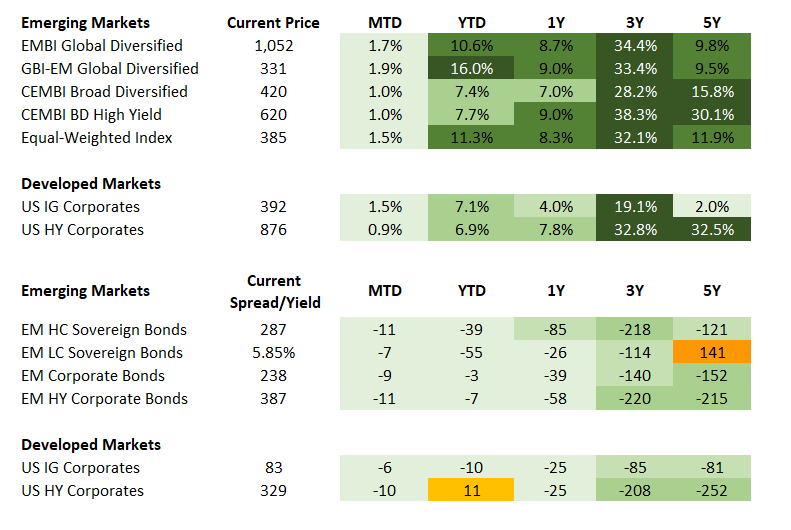
Equities
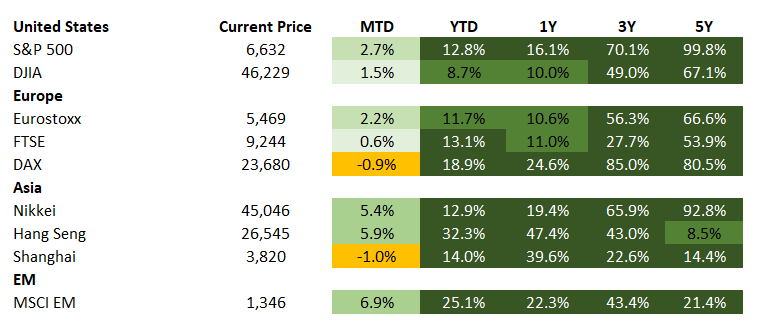
Commodities

Source for data tables: Bloomberg, JPMorgan, Gramercy. EM Fixed Income is represented by the following JPMorgan Indicies: EMBI Global, GBI-EM Global Diversified, CEMBI Broad Diversified and CEMBI Broad High Yield. DM Fixed Income is represented by the JPMorgan JULI Total Return Index and Domestic High Yield Index. Fixed Income, Equity and Commodity data is as of Sept. 19, 2025 (mid-day).
Highlights
Argentine Peso Breaches Upper Limit Amid Political Volatility
Event: Amid congressional overturn of President Javier Milei’s vetoes against recent healthcare and university bills, the peso breached the upper band of the currency framework, prompting the central bank to sell dollars to defend the level. This follows Mr. Milei’s recent, and so far unsuccessful, efforts to improve the political landscape in the aftermath of the ruling party’s loss in the Province of Buenos Aires election earlier this month. These efforts included the formation of a political committee and real spending increases in education, healthcare, and pensions in the 2026 budget. Global dollar bonds were down around 5bps over the week.
Gramercy Comment: We expect the authorities to continue defending the upper currency band with dollar sales, albeit with limitations. The challenging political backdrop and near-term implications for the macroeconomic landscape through the foreign exchange market has increased the probability of a liability management exercise next year. We expect continued foreign exchange and asset price volatility between now and the national mid-term vote on October 26th – with room for material policy adjustment thereafter. The willingness and ability to execute on further macroeconomic adjustment into 2026 will determine the evolution of bond prices and the likelihood of regaining international market access.
Peru’s Congress Approves Another Pension Withdrawal
Event: In the face of growing social pressure, Peru’s Congress overwhelmingly approved an eighth pension withdrawal, estimated at roughly $9 billion, this week. Additional provisions include future eligibility for a minimum pension, a shift from mandatory to voluntary contributions for independent workers, and the right to withdraw up to 95.5% of pensioners’ accumulated savings upon retirement. Pension savings have dropped by more than 12% of GDP since the first withdrawal bill.
Gramercy Comment: Speculation over another withdrawal approval gained momentum last week and over the weekend as President Dina Boluarte endorsed the measure, pushing up local yields. Pension-related selling may further weigh on local yields and liquidity in the near-term, assuming all else is equal. The income boost for consumers should incrementally lift growth into next year, while the central bank may take a more patient approach to future rate cuts in order to assess the impact of outflows.
Emerging Markets Technicals
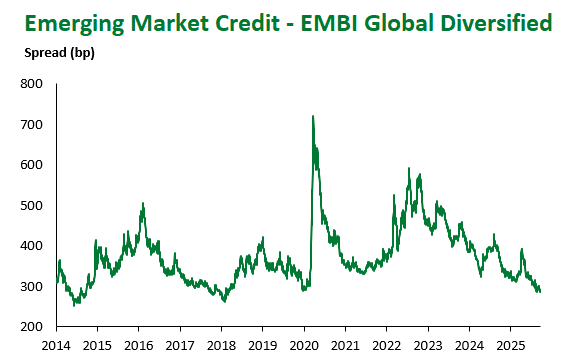

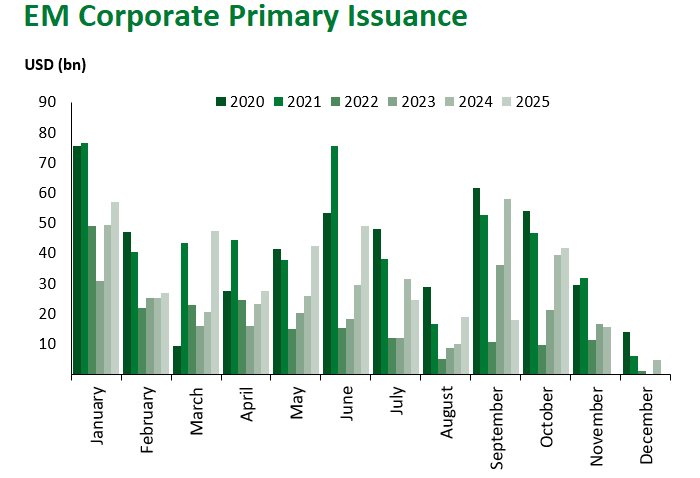
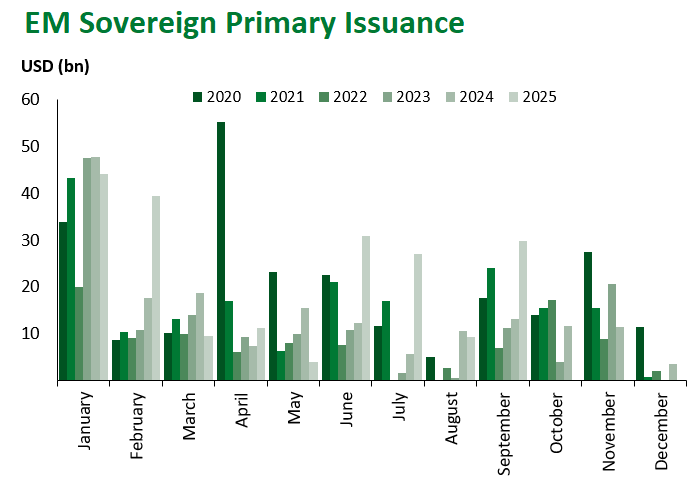
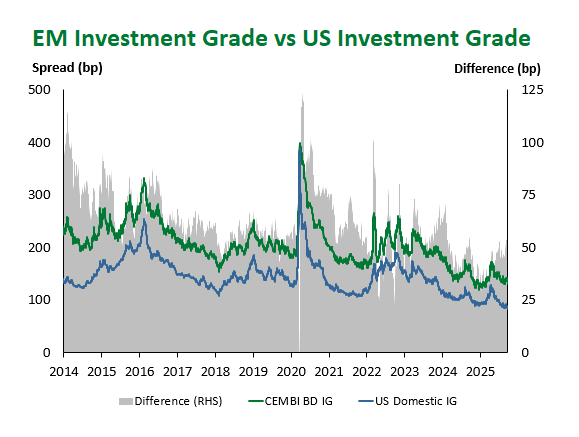
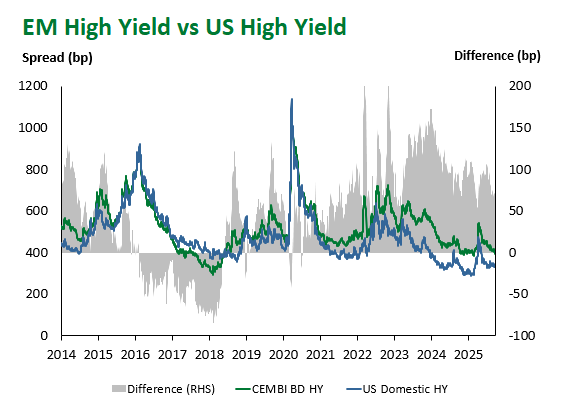
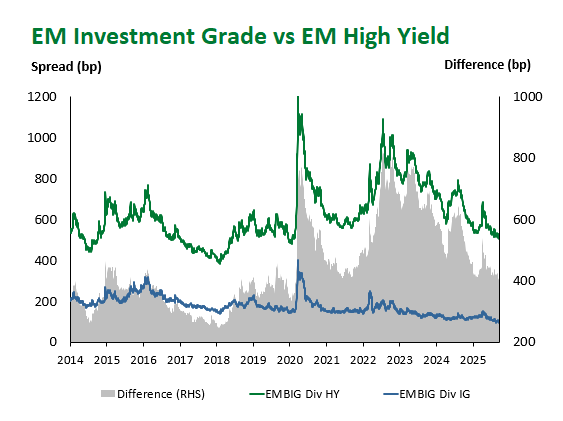
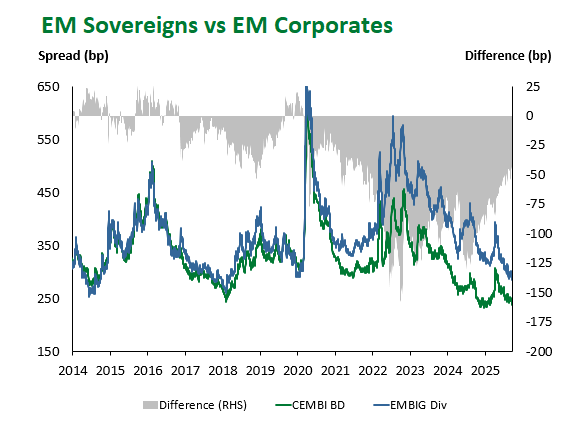
Emerging Markets Flows
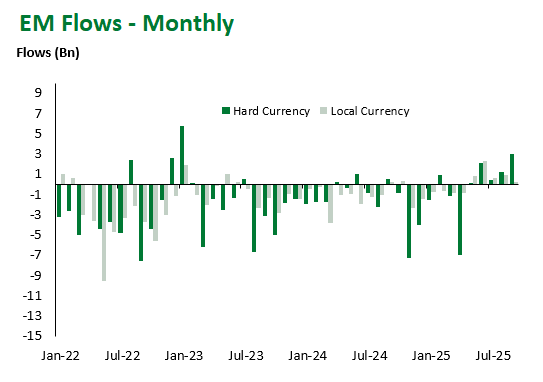
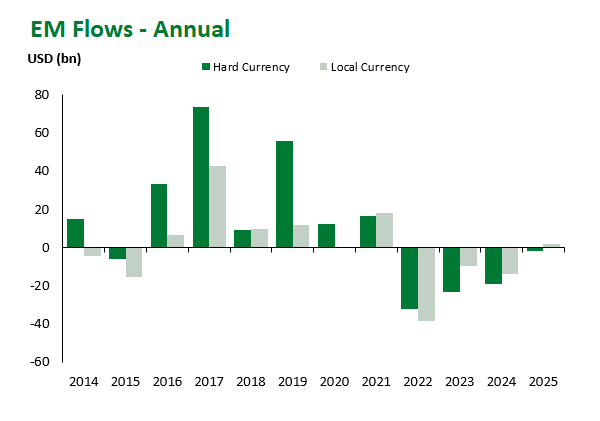
Source for graphs: Bloomberg, JPMorgan, Gramercy. As of Sept. 19, 2025.
For questions, please contact:
Kathryn Exum, CFA ESG, Director, Co-Head of Sovereign Research, [email protected]
Petar Atanasov, Director, Co-Head of Sovereign Research, [email protected]
This document is for informational purposes only. The information presented is not intended to be relied upon as a forecast, research or investment advice, and is not a recommendation, offer or solicitation to buy or sell any securities or to adopt any investment strategy. Gramercy may have current investment positions in the securities or sovereigns mentioned above. The information and opinions contained in this paper are as of the date of initial publication, derived from proprietary and nonproprietary sources deemed by Gramercy to be reliable, are not necessarily all-inclusive and are not guaranteed as to accuracy. This paper may contain “forward-looking” information that is not purely historical in nature. Such information may include, among other things, projections and forecasts. There is no guarantee that any forecasts made will come to pass. Reliance upon information in this paper is at the sole discretion of the reader. You should not rely on this presentation as the basis upon which to make an investment decision. Investment involves risk. There can be no assurance that investment objectives will be achieved. Investors must be prepared to bear the risk of a total loss of their investment. These risks are often heightened for investments in emerging/developing markets or smaller capital markets. International investing involves risks, including risks related to foreign currency, limited liquidity, less government regulation, and the possibility of substantial volatility due to adverse political, economic or other developments. References to any indices are for informational and general comparative purposes only. The performance data of various indices mentioned in this update are updated and released on a periodic basis before finalization. The performance data of various indices presented herein was current as of the date of the presentation. Please refer to data returns of the separate indices if you desire additional or updated information. Indices are unmanaged, and their performance results do not reflect the impact of fees, expenses, or taxes that may be incurred through an investment with Gramercy. Returns for indices assume dividend reinvestment. An investment cannot be made directly in an index. Accordingly, comparing results shown to those of such indices may be of limited use. The information provided herein is neither tax nor legal advice. Investors should speak to their tax professional for specific information regarding their tax situation.
